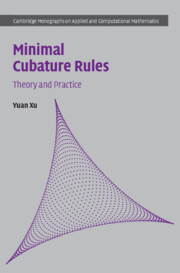Refine search
Actions for selected content:
3386167 results
5 - Seeing the Word
- from Part II - A Sign for This Generation: Reading the Gospels with Origen
-
- Book:
- The Life of Jesus in the Writings of Origen of Alexandria
- Published online:
- 26 September 2025
- Print publication:
- 16 October 2025, pp 92-114
-
- Chapter
- Export citation
Acknowledgements
-
- Book:
- Law and Constitutional Change
- Published online:
- 26 September 2025
- Print publication:
- 16 October 2025, pp xiii-xiv
-
- Chapter
-
- You have access
- Open access
- HTML
- Export citation
Part I - The Origins of “Thought Experiment” in Kant and Ørsted
-
- Book:
- Kierkegaard and the Structure of Imagination
- Published online:
- 26 September 2025
- Print publication:
- 16 October 2025, pp 21-86
-
- Chapter
- Export citation
1 - Introduction: The Personal Is Political – How I Came to Write This Book
-
- Book:
- Tied Up in Tehran
- Published online:
- 28 September 2025
- Print publication:
- 16 October 2025, pp 1-23
-
- Chapter
- Export citation
Part I - Law and Governance
-
- Book:
- Modern Slavery and the Governance of Global Value Chains
- Published online:
- 17 September 2025
- Print publication:
- 16 October 2025, pp 39-40
-
- Chapter
-
- You have access
- Open access
- Export citation
Acknowledgements
-
- Book:
- Cyril of Alexandria: <i>Against Julian</i>
- Published online:
- 26 September 2025
- Print publication:
- 16 October 2025, pp ix-x
-
- Chapter
- Export citation
Book 9
- from Against Julian
-
- Book:
- Cyril of Alexandria: <i>Against Julian</i>
- Published online:
- 26 September 2025
- Print publication:
- 16 October 2025, pp 439-489
-
- Chapter
- Export citation
Contents
-
- Book:
- Minority Identities in Nigeria
- Published online:
- 26 September 2025
- Print publication:
- 16 October 2025, pp vii-vii
-
- Chapter
- Export citation
Frontmatter
-
- Book:
- Modern Slavery and the Governance of Global Value Chains
- Published online:
- 17 September 2025
- Print publication:
- 16 October 2025, pp i-vi
-
- Chapter
-
- You have access
- Open access
- Export citation

Minimal Cubature Rules
- Theory and Practice
- Coming soon
-
- Expected online publication date:
- October 2025
- Print publication:
- 30 October 2025
-
- Book
- Export citation
Epigraph
-
- Book:
- Hegel Beyond Liberalism
- Published online:
- 27 September 2025
- Print publication:
- 16 October 2025, pp v-vi
-
- Chapter
- Export citation
Dedication to the Most Pious and Christ-loving Emperor Theodosius
- from Against Julian
-
- Book:
- Cyril of Alexandria: <i>Against Julian</i>
- Published online:
- 26 September 2025
- Print publication:
- 16 October 2025, pp 67-70
-
- Chapter
- Export citation
4 - Tensions in the Reconstruction of Indian Religion: Universalism and Pluralism
-
- Book:
- Chips from a Calcutta Workshop
- Published online:
- 26 September 2025
- Print publication:
- 16 October 2025, pp 144-183
-
- Chapter
- Export citation
Chapter 3 - Ørsted, Mach, and the History of Thought Experiment
- from Part I - The Origins of “Thought Experiment” in Kant and Ørsted
-
- Book:
- Kierkegaard and the Structure of Imagination
- Published online:
- 26 September 2025
- Print publication:
- 16 October 2025, pp 47-62
-
- Chapter
- Export citation
11 - We Are More Than One, When We Speak Together: Collective Art, Plural Possibilities, and the Horizon of Utopia
-
- Book:
- Tied Up in Tehran
- Published online:
- 28 September 2025
- Print publication:
- 16 October 2025, pp 294-316
-
- Chapter
- Export citation
Fragments
- from Against Julian
-
- Book:
- Cyril of Alexandria: <i>Against Julian</i>
- Published online:
- 26 September 2025
- Print publication:
- 16 October 2025, pp 537-578
-
- Chapter
- Export citation
Chapter 1 - Leadership in Third-Millennium Mesopotamia
-
-
- Book:
- Leadership in the Ancient World
- Published online:
- 14 September 2025
- Print publication:
- 16 October 2025, pp 14-33
-
- Chapter
- Export citation
Bibliography
-
- Book:
- A Theory of International Organizations in Public International Law
- Published online:
- 26 September 2025
- Print publication:
- 16 October 2025, pp 249-271
-
- Chapter
- Export citation
Contents
-
- Book:
- An Empire of Images
- Published online:
- 26 September 2025
- Print publication:
- 16 October 2025, pp ix-x
-
- Chapter
- Export citation
Figures
-
- Book:
- Applied Healthcare Economics
- Published online:
- 26 September 2025
- Print publication:
- 16 October 2025, pp xi-xi
-
- Chapter
- Export citation
